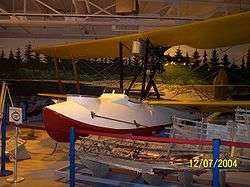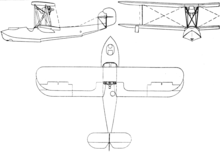Canadian Vickers Vedette
The Canadian Vickers Vedette was the first aircraft in Canada designed and built to meet a specification for Canadian conditions. It was a single-engine biplane flying boat purchased to meet a Royal Canadian Air Force (RCAF) demand for a smaller aircraft than the Vickers Viking with a much greater rate of climb, to be suitable for forestry survey and fire protection work. The type went on to have a long and distinguished career in civil operations in Canada. Most of the topographical maps in use in Canada today are based on photos taken from these aircraft.
| Canadian Vickers Vedette | |
|---|---|
 | |
| Role | amphibious general aviation survey |
| Manufacturer | Canadian Vickers |
| Designer | Wilfrid Thomas Reid (preliminary study by R.K.Pierson) |
| First flight | 4 November 1924 |
| Introduction | 1925 |
| Retired | 1941 |
| Primary users | Royal Canadian Air Force Ontario Provincial Air Service Manitoba Government Air Services Servició de Aviación Militar de Chile |
| Produced | 1924–1930 |
| Number built | 60[1] (plus two replicas) |
| Unit cost |
$15,000 less engine. |
Design and development
Based on a preliminary design in early 1924 for a "flying boat" by R.K.Pierson of the home company, Vickers (UK), the Canadian Vickers Vedette was a two/three-seat single-engine pusher aircraft. The design was passed over to the Canadian Vickers Limited of Longueuil, Quebec (formed in 1911) where Wilfrid Thomas Reid served as Chief Engineer.[2]
The prototype Vedette I was first flown on 4 November 1924, powered by a 200 hp (150 kW) Rolls-Royce Falcon III. It was subsequently fitted with 210 hp (160 kW) Wolseley Viper, 200 hp (150 kW) Wright J-4 and 215 hp (160 kW) Armstrong Siddeley Lynx engines for testing. Several versions of the Vedette were produced, including two amphibious versions and one with an enclosed cabin on an all-metal hull. With the exception of these major changes, most of the remaining differences between versions were relatively minor and not externally visible. Each version was produced with a range of optional engine types.[2]
Canadian Vickers Limited developed and produced a series of follow-up designs intended for use in the Canadian north (none were related design-wise to the Vedette):
- Canadian Vickers Vista A small monoplane pusher, almost a Vedette without the top wing.
- Canadian Vickers Varuna Twin-engine seaplane, essentially a scaled-up Vedette.
- Canadian Vickers Vancouver Similar to the Varuna, but with detail improvements.
- Canadian Vickers Vanessa Biplane floatplane.
Operational history
The first production example was provided to Fairchild Aerial Surveys (c/n 31 G-CAFF) before they started designing their own survey aircraft. The majority of the production run was purchased by the RCAF where the aircraft proved popular and versatile, if somewhat temperamental due to leaky hulls that required constant maintenance (a problem afflicting all wooden hulled flying boats). The Vedette undertook photographic and forestry patrols satisfactorily and provided a backbone for RCAF flying operations through the lean peacetime years. Vedettes started a coast-to-coast photographic survey that was needed to map out the large areas of the country still unmapped. These missions lasted until the outbreak of the Second World War, and would be completed after the war with newer types. Vedettes stationed on both coasts were also used for fishing and smuggling patrols, both with the RCAF and with Western Canada Airways.
The Vedette featured prominently in a number of mercy missions, while some airmen discovered it was nearly ideal for aerial goose hunting, at least until a pilot was hit by a goose. The first Canadian to join the Caterpillar Club by using a parachute to escape from an aircraft did so from RCAF Vedette "ZF" on 17 May 1929. The pilot, C.S. (Jack) Caldwell, while testing the aircraft at the Canadian Vickers factory, entered an uncontrollable spin after the engine failed and bailed out successfully over the St. Lawrence River.
The RCAF acquired one Wright J-4 engined Vedette I in 1925 and 18 Armstrong-Siddeley Lynx IV (210 hp (160 kW)) engined Vedette IIs from 1926 onwards. All of these were out of service before the Second World War began. Starting in 1929, the RCAF acquired 13 Vedette Vs with a higher gross weight, and 11 fitted with Handley Page wing slots as the Vedette Va. The single Vedette VI, with Wright J-6 engine, featured a metal hull and an enclosed cockpit. A mark V was refurbished by the factory and as the sole Vam was given a new metal hull, as well as a new serial number (the last), but it retained its RCAF call sign as "ZD." The Mk VI and seven Vedette Va flying boats survived into wartime service, flying with No 4(BR) Squadron and the Seaplane and Bomber Reconnaissance Training School (later No 13 OT Sqn) in Vancouver, BC until May 1941.
In addition to the RCAF, The Ontario, Manitoba and Saskatchewan governments used Vedettes extensively for scouting out forest fires in the heavily wooded areas of those provinces.
The company exported six Wright J-5 powered Vedette Vs to Chile, where they were based at Puerto Montt (which is on an inlet off the Pacific coast) with the Escuadrilla de Anfibios N° 1 (now known as the Grupo de Aviación N° 5). They were used to forge an air link between there and the capital Santiago, 569 miles (916 km) up the coast. At least one of the Vedettes, and possibly all six were lost due to hurricane-force winds, which also caused the loss of two lives when one of the aircraft overturned while on the water.
Operators
- Royal Canadian Air Force (45 used)
- Fairchild Aerial Surveys (1 used)
- Manitoba (Government) Air Service (7 used)
- Ontario Provincial Air Service (2 used)
- Government of Saskatchewan (5 used)
- Western Canada Airways Ltd. (1 used)
- Canadian Airways (1 used)
- Chilean Air Force
- Escuadrilla de Anfibios N° 1 (6 used)
Variants
- Vedette I
- Prototype (c/n 9) tested variously with Rolls-Royce Falcon III, Wolseley Viper, Wright J-4 and Armstrong Siddeley Lynx engines.
- Vedette II
- Production version, modified rudder and other minor changes from prototype.
- Vedette III & IV
- Not built, but may have included an enclosed cabin transport.
- Vedette V
- Improved amphibian version, but most not equipped with wheels.
- Vedette Va
- Mk.V fitted with Handley-Page leading edge slots.
- Vedette Vam
- One off Mk.V (c/n 123/170) refurbished with metal hull.
- Vedette VI
- One off (c/n 163) with metal hull and Handley-Page leading edge slots.[3]
- Vassal I
- Proposed variant using Clark Y airfoil section wings, not built.
Survivors

There are no original intact surviving examples of the Vickers Vedette known to exist. There are, however two replicas in Canadian museums.
The first is a replica of a Vedette V (CF-MAG) at the Western Canada Aviation Museum, Winnipeg, Manitoba. Unveiled on 24 May 2002, this replica was built using templates made from analyzing the remains of three separate Vedette wrecks. These fragments from three separate aircraft would form the groundwork for the creation of blueprints. This project took a group of more than 100 dedicated volunteers 22 years to complete. The build was aided by hand drawn plans created by one of the WCAM volunteers who had been employed by Canadian Vickers as a junior draughtsman. The replica was built according to airworthy standards of the 1920s, however the museum has no plans to fly it, and it has not been certified.
While three wrecks were used, the bulk of the information was contributed by CF-MAG. For this reason, it was decided to include this former registration number on the hull for historical authenticity.
The original CF-MAG was built in 1929 and was placed in storage until it was purchased by the Government of Manitoba in 1934, along with five ex-RCAF Vedettes (for $1 each) to be used for forest fire patrols. In 1937, the engine of CF-MAG failed while on a flight to Cormorant Lake Manitoba. The pilot touched down in a swamp, then walked to an area where he could be rescued. A week later, an attempt was made to retrieve the downed aircraft, but the swamp was too small to permit takeoff. After all the usable parts were salvaged, the hull was soaked with fuel and the Vedette set on fire.[4]
A second wreck was recovered (G-CASW), which had crashed into a mountain on Porcher Island British Columbia while conducting a forest fire survey and was also recovered to aid in the design and blueprinting by WCAM,
Finally, preserved pieces of a third Vedette were loaned to the museum by the National Aeronautical Museum in Ottawa.[5]
The second replica is on display at the Saskatchewan Western Development Museum In 2003, the WDM acquired part of an original hull, which is displayed as an artifact in condition as found. With plans loaned from the Western Canada Aviation Museum, a group of volunteers from the Vintage Aircraft Restorers undertook the construction. It has been completed as of early 2017.[6] In 2014, the VAR Vendette Project won a Ninety-Nines Canadian Award in Aviation.
Specifications (Mk II, Lynx engine)

Data from Jane's all the World's Aircraft 1928,[7] The Canadian Vickers Vedette, Canadian Aeronautics and Space Journal, October 1964.[8]
General characteristics
- Crew: 3
- Length: 22 ft 10 in (6.95 m)
- Wingspan: 42 ft 0 in (12.8 m)
- Height: 11 ft 9 in (3.58 m)
- Wing area: 483 sq ft (44.9 m2)
- Airfoil: RAF 15
- Empty weight: 1,849 lb (839 kg)
- Gross weight: 3,049 lb (1,383 kg)
- Fuel capacity: 535 lb (243 kg) fuel and oil
- Powerplant: 1 × Armstrong Siddeley Lynx IV 7-cyliner air-cooled radial piston engine, 187 hp (139 kW)
- Propellers: 2-bladed fixed pitch pusher propeller
Performance
- Maximum speed: 59 mph (95 km/h, 51 kn) at sea level; 87 mph (76 kn; 140 km/h) at 10,000 ft (3,000 m)
- Cruise speed: 47 mph (75 km/h, 40 kn) at 5,000 ft (1,500 m)
- Endurance: 5 hours
- Service ceiling: 13,000 ft (4,000 m)
- Rate of climb: 650 ft/min (3.3 m/s)
- Time to altitude: 10,000 ft (3,000 m) in 30 minutes
- Wing loading: 6.28 lb/sq ft (30.7 kg/m2)
- Power/mass: 0.059 hp/lb (0.097 kW/kg)
References
- "History of Flight#CanadianVickersVedette". Canadian Historical Aircraft Association (old website). Archived from the original on 15 August 2011. Retrieved 29 December 2018.
- Molson, K.M.; Taylor, H.A. (1982). Canadian aircraft since 1909 (1. publ. ed.). Stittsville, Ont.: Canada's Wings. p. 174. ISBN 0-920002-11-0.
- Grey, C.G., ed. (1931). Jane's all the World's Aircraft 1931. London: Sampson Low, Marston & company, ltd. pp. 82c–83c.
- "Vickers Vedette, CF-MAG | Royal Aviation Museum of Western Canada". www.royalaviationmuseum.com. Retrieved 26 February 2016.
- "Vedette–Return of a Classic". Royal Aviation Museum of Western Canada. Retrieved 12 March 2017.
- Lowe, Angie (19 February 2017). "1924 Vickers Vedette Flying Boat Full Restoration Complete". Discover Moose Jaw / Golden West Broadcasting. Archived from the original on 21 February 2017. Retrieved 12 March 2017.
- Grey, C.G., ed. (1928). Jane's all the World's Aircraft 1928. London: Sampson Low, Marston & company, ltd. pp. 68c–69c.
- Molson, Kenneth M. (October 1964). "The Canadian Vickers Vedette". Canadian Aeronautics and Space Journal.
Further reading
- Milberry, Larry (1979). Aviation in Canada (Hc. ed.). Toronto: McGraw-Hill Ryerson. ISBN 0-07-082778-8.
External links
| Wikimedia Commons has media related to Canadian Vickers Vedette. |
- "Accidentes aéreos en el sur de Chile". Retrieved 7 March 2018.
- Film of the Vickers Vedette operating in BC
- Canadian Vickers Vedette – British Aircraft of World War II
- Canadian Air Force